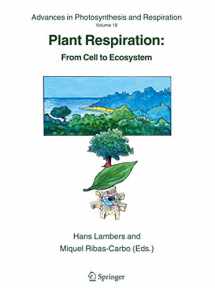
Plant Respiration: From Cell to Ecosystem (Advances in Photosynthesis and Respiration, 18)
ISBN-13:
9781402035883
ISBN-10:
1402035888
Edition:
2005
Author:
Hans Lambers, Universitat Illes Balears
Publication date:
2005
Publisher:
Springer
Format:
Hardcover
270 pages
FREE US shipping
Book details
ISBN-13:
9781402035883
ISBN-10:
1402035888
Edition:
2005
Author:
Hans Lambers, Universitat Illes Balears
Publication date:
2005
Publisher:
Springer
Format:
Hardcover
270 pages
Summary
Plant Respiration: From Cell to Ecosystem (Advances in Photosynthesis and Respiration, 18) (ISBN-13: 9781402035883 and ISBN-10: 1402035888), written by authors
Hans Lambers, Universitat Illes Balears, was published by Springer in 2005.
With an overall rating of 3.5 stars, it's a notable title among other
books. You can easily purchase or rent Plant Respiration: From Cell to Ecosystem (Advances in Photosynthesis and Respiration, 18) (Hardcover) from BooksRun,
along with many other new and used
books
and textbooks.
And, if you're looking to sell your copy, our current buyback offer is $0.3.
Description
Respiration in plants, as in all living organisms, is essential to provide metabolic energy and carbon skeletons for growth and maintenance. As such, respiration is an essential component of a plant’s carbon budget. Depending on species and environmental conditions, it consumes 25-75% of all the carbohydrates produced in photosynthesis – even more at extremely slow growth rates. Respiration in plants can also proceed in a manner that produces neither metabolic energy nor carbon skeletons, but heat. This type of respiration involves the cyanide-resistant, alternative oxidase; it is unique to plants, and resides in the mitochondria. The activity of this alternative pathway can be measured based on a difference in fractionation of oxygen isotopes between the cytochrome and the alternative oxidase. Heat production is important in some flowers to attract pollinators; however, the alternative oxidase also plays a major role in leaves and roots of most plants. A common thread throughout this volume is to link respiration, including alternative oxidase activity, to plant functioning in different environments.


We would LOVE it if you could help us and other readers by reviewing the book
Book review

Congratulations! We have received your book review.
{user}
{createdAt}
by {truncated_author}


